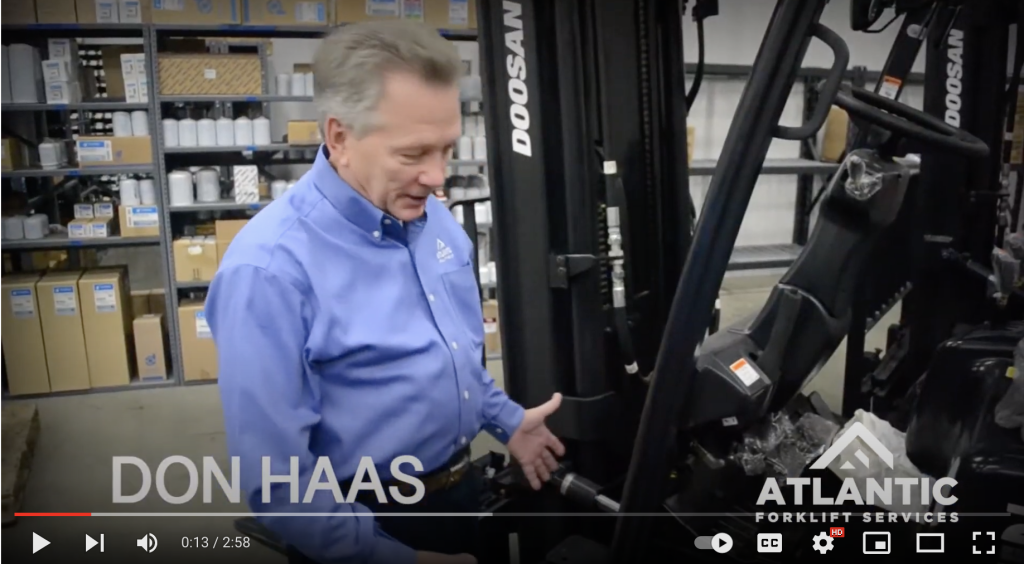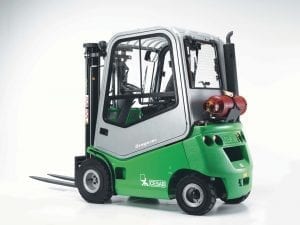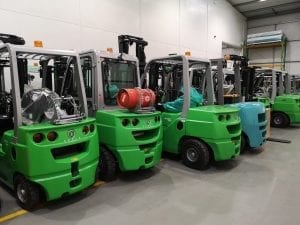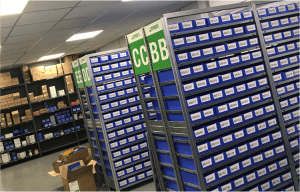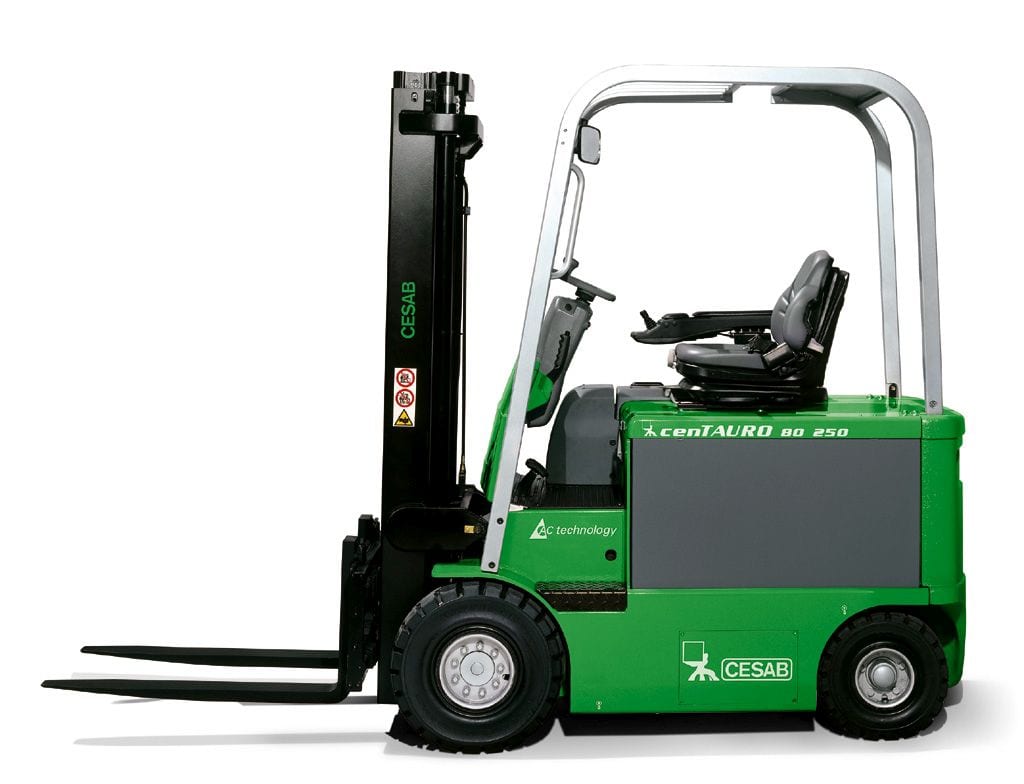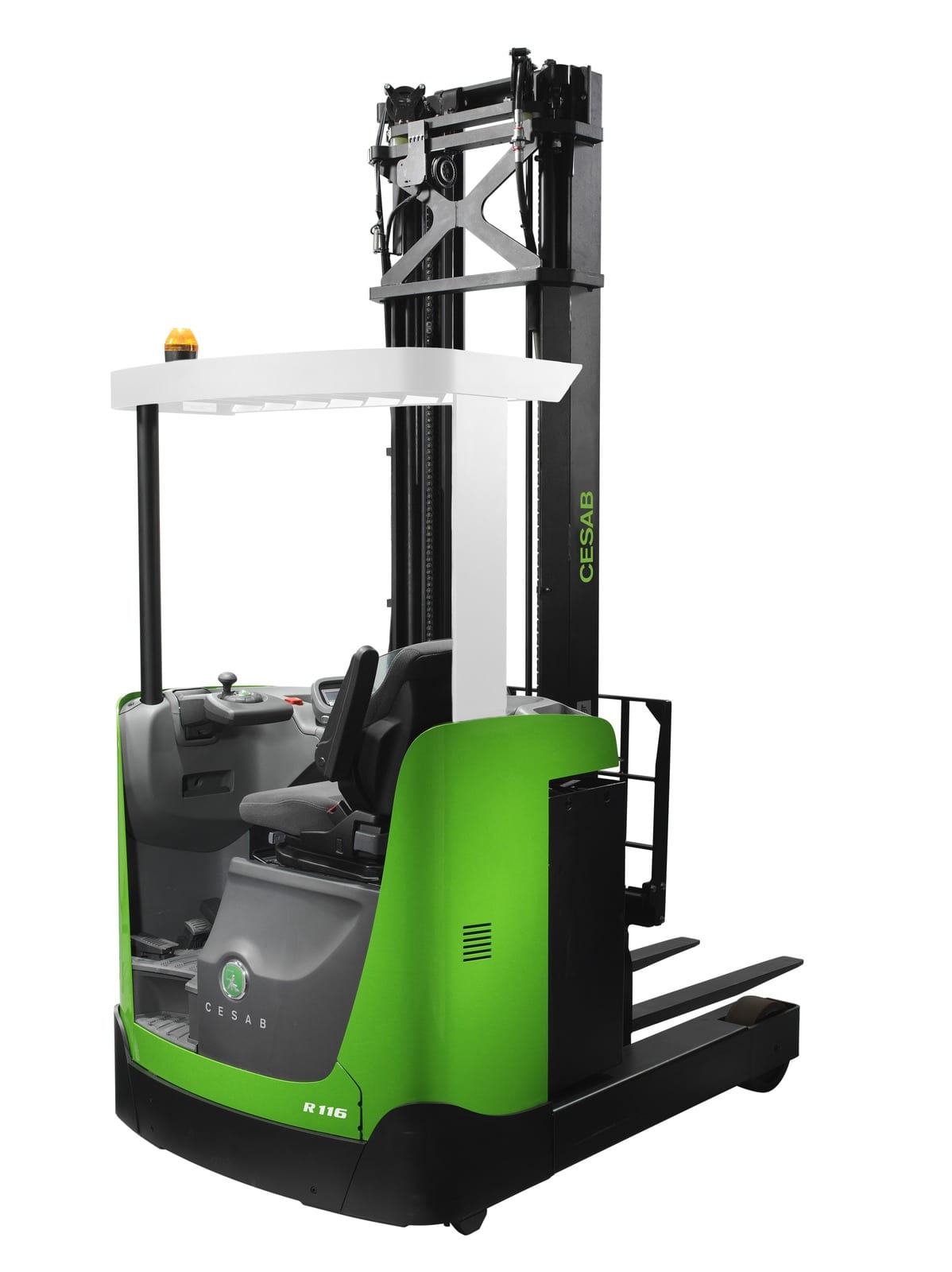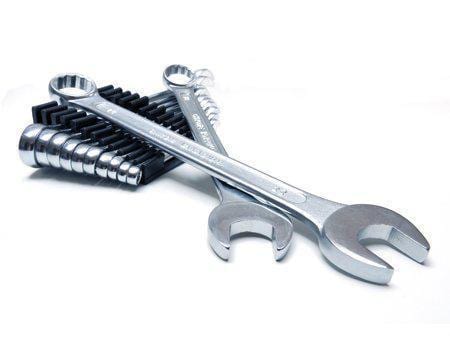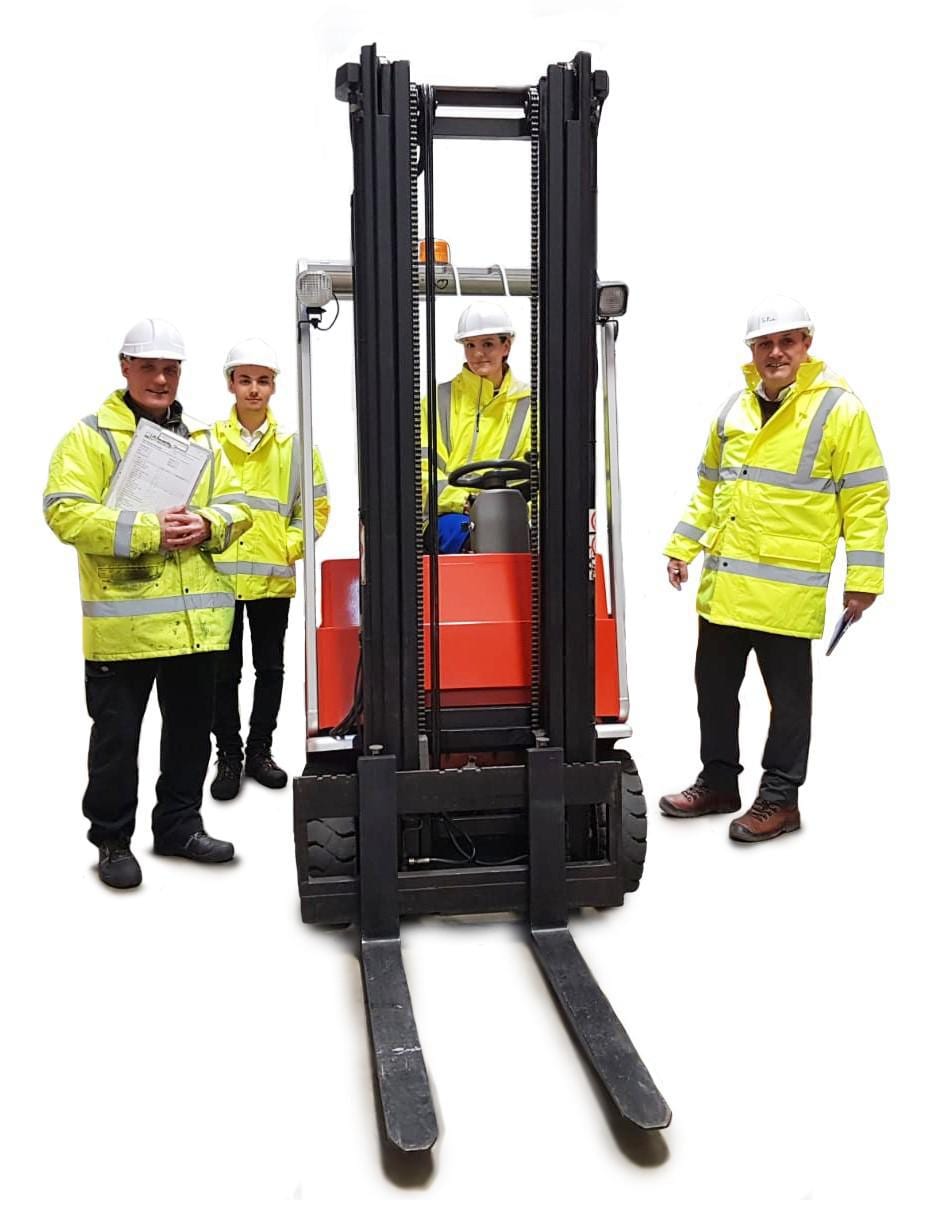The forklift is a uniquely versatile work vehicle designed for quickly moving heavy cargo loads through a warehouse or industrial worksite.
Anyone who operates a forklift or manages an operation using these machines should gain an understanding of what are the parts of a forklift.
A forklift operates with three points of stability — the two front wheels and the centre of the rear axle — and works on flat or mostly smooth surfaces. Today, we see a trend moving into automated forklifts that are computer-controlled. However, most forklifts throughout various industries get operated by a human forklift driver.
What are the parts of a forklift? Angus Lift Trucks covers the three major parts of the forklift and various forklift parts & functions.
Forklift Tyres
Among the essential aspects of forklift parts and functions are the forklift tyres.
Forklift tyres come in three main types: Cushion, air pneumatic, and solid pneumatic. The different forklift tyre types outfit the vehicle for operating on various surfaces, including concrete, asphalt, and loose gravel. Of course, you can often use old tyres in super creative ways as our article on 20 Amazingly Inventive Ways to Re-Use Old Forklift Tyres proves.
Cushion Tyres
Made of solid rubber, cushion tyres are wrapped directly around the forklift wheels. Such cushion tyres work best on warehouse floors or on paved surfaces that are even. They ride lower to the ground for a tighter turning radius, which provides more excellent manoeuvrability in tight spaces. These forklift tyres are best-suited for indoor operation.
Pneumatic Tyres
The pneumatic tyre is the most common forklift tyre throughout the industry. Highly durable with long life, the pneumatic tyre consists of solid rubber. Pneumatic tyres are more expensive than cushion tyres and also offer a less comfortable ride for the operator. These forklift tyres get used for jobs that require indoor and outdoor work, moving through warehouses to outside storage areas.
Pneumatic Air-Filled Tires
Pneumatic air-filled tires are made of rubber but filled with air, just like any truck or passenger vehicle tire. The more durable tires offer a deep tread for better traction. These tires are best suited for outdoor forklift operation.
Forklift Frame
If you’re wondering, what are the three major parts of a forklift, the frame is one of them. The forklift frame, overhead guard, and hydraulic lift compose the three essential parts of the standard forklift.
The forklift frame is the chassis, or base, to which the mast, wheel axles, counterweight, and overhead guard are securely attached. The hydraulic fluid tank is also attached to the frame and either the fuel tank or battery.
Counterweight Forklift
The counterweight helps to keep the forklift stable on its three balance points as the machine lifts and manoeuvres with heavy loads. The maximum lift capacity for a forklift depends upon the counterweight. Thus, operators need to check the maximum carrying capacity to ensure that it’s appropriate for the job.
On some electric-powered forklifts, the battery may serve as the counterweight. On the more common internal combustion forklift, the counterweight is located in the back at the centre of the rear axle, opposite the lift fork.
Among forklift parts, the counterweight is absolutely crucial to maintaining the proper balance.
Forklift Overhead Guard
The forklift overhead guard protects the operator from falling objects in a warehouse or outdoor worksite. Forklift operators may inadvertently dislodge objects while reaching overhead to pull cargo stored on shelving.
Operators should also wear a hardhat for additional protection from falling objects while keeping hands and feet within the forklift frame.
Forklift Main Lift Cylinder
Among essential forklift parts & functions is the forklift main lift cylinder, which performs the machine’s primary function.
The forklift main lift cylinder is a hydraulic cylinder that pushes the mast vertically. In the lift position, the control valve directs hydraulic fluid to the lift cylinder and rod. The flow control valve regulates the backflow of hydraulic fluid for a smooth downward motion when lowering the lift forks.
Forklift Tilt Cylinder
The forklift lift cylinder is not to be confused with the forklift tilt cylinder. While a lift cylinder facilitates vertical movement of the mass, the tilt cylinder is used to tilt the mass.
A tilt cylinder is what is known as a hydraulic cylinder, which is a mechanical movement that is produced by a pumped liquid. The upshot of this technology is that it can pull and push its load. Forklifts typically have two tilt cylinders, which give operators a lot of control when tilting in both reverse and forward.
Forklift Cab
The forklift cab is the space within the frame where the operator sits. The cab contains the operator seat and forklift controls used to manoeuvre the vehicle and components, including the vertical control for the mast and forks.
Forklift Seat
The forklift seat provides a place for the operator to sit in front of the hand controls and foot pedals to manoeuvre the machine. Although that’s not necessarily a safety standard, most forklifts with sit-down operator controls come with seat belts.
As specified in the owner and maintenance manual, some forklifts are designed for the operator to stand while controlling the vehicle.
Forklift Steering Wheel
The forklift steering wheel allows the operator to turn the front wheels and thus manoeuvre the vehicle. Some forklifts come with steering wheels with an attached knob that allows for tighter turns.
Forklift Levers
The three main forklift levers are located near the steering wheel in front of the operator seat. The operator uses the steering wheel and these levers by hand and foot pedals on the cab floor.
Tilt Lever
The tilt lever controls the angle relative to the ground, allowing the operator to tilt the forks clockwise or counterclockwise.
Lift Lever
The lift lever controls the height of the forks, with the mast hydraulically lifting along with the attached forks.
Side Shift Lever
The side shift lever controls the lateral movement of the carriage, allowing the operator to swivel the vehicle around on its base.
Forklift Mast
The forklift mast is the upright part of the machine that lifts and positions the loads carried by the forks. Different types of forklift masts confer advantages for varying applications based on height and lifting requirements.
Forklift Carriage
The forklift carriage consists of the forklift mast, load backrest, and forks used to manipulate cargo loads. The carriage includes any forklift parts that come into direct contact with the load.
You can find the forklift carriage between the forklift mast and the and the forks. It’s used to mount forklift attachments, like forks and forklift backrest. If your machine has a forklift carriage bumper, you can also find it here.
Forklift carriages come in five different classes based on carriage height. These sizes also determine the carriage lifting capabilities, with Class A rated for under 2,200 lbs and Class E capable of lifting between 17,000 and 24,000 lbs.
Forklift Load Backrest
The forklift load backrest provides a second surface against which the operator may rest the cargo load. The load backrest runs perpendicular to the forks and is attached to the carriage. The forklift load backrest is the forklift part that prevents the cargo load from moving backward toward the cab and the operator.
Thus, the forklift load backrest protects the operator from injury and the other forklift parts from damage. You should never use the forklift with the load backrest removed for operator safety and to safeguard the machine.
Forklift Attachments
What are the three major parts of a forklift? The fork attachments are critical to efficient work in a warehouse or industrial site.
Among the forklift parts list, attachments are essential to consider when designing or revamping workflow at a facility or temporary job site. Often, the forklift operator is the lynchpin to operations in an assembly plant or similar facility, where many labourers depend upon just-in-time inventory delivery.
Modifying the forklift with attachments is often a good productivity and efficiency.
The attachments allow the forklift to handle different types of cargo loads more efficiently, rather than the standard wooden pallet found in most warehouses. Attachments may enable the forklift to push, pull, lift, rotate, or shift a load to the side. The right attachments also allow the operator to clamp onto a load, like a vice grip.
By choosing the correct forklift attachments, managers may help to improve worker safety, reduce pallet and product damage, and increase workflow efficiency. Following is a comprehensive forklift parts list of commonly used attachments.
Side Shifter
The side shifter is the most commonly used attachment for the forklift. The side shifter attachment allows the operator to simply move the cargo load laterally, making small adjustments without needing to drop the load to the floor to realign the forks.
The side shifter attachment helps to reduce damage to wooden pallets, which reduces repair and replacement costs. The common attachment also helps to facilitate quicker movement and less time spent loading and unloading pallets. Less time on the forklift also means fuel and maintenance savings over time.
As an ancillary benefit, the side shifter attachment allows the operator to stack columns closer together, thereby saving warehouse space for greater efficiency.
Paper Clamp
Many forklift attachments are designed for specific tasks in one or two industries. The paper clamp attachment is one such forklift part, used primarily by printing and paper industries. The attachment is designed to handle large paper rolls efficiently without damaging the product. For more excellent value, the attachment may also be used on other types of machines, although its primary use is via forklift.
Fork Positioner
The fork positioner attachment allows the operator to position the forklift forks via hydraulics. This attachment helps to speed the handling of different sized loads in a warehouse, which frequently occurs in many cases.
The fork positioner increases productivity and negates the need for the operator to manually adjust forks for different sized loads.
Push/Pull Attachment
The push/pull attachment allows the forklift operator to manoeuvre cargo loads positioned on slip sheets, which are less expensive than traditional wooden pallets. Some lower-weight cargo loads are kept on slip sheets to increase shipping volume.
The attachment allows for quick installation and removal, conveniently fitting over the forks. This attachment is typically used to manoeuvre cargo such as beverages, packaged food, and bagged goods.
Fork Extensions
Fork extensions offer a simple and convenient way to extend the forks for cargo loads longer in length or otherwise awkward proportion. The attachments increase load stability for more excellent safety.
Multiple Pallet Attachment
The multiple pallet attachment handles multiple pallets placed side by side. The attachment helps the operator save time and increase efficiency. Typically, this attachment is used in manufacturing and shipping facilities.
Forklift Battery
Forklift batteries are a big part of the modern wave of forklift trucks. Typically, they are either lead-acid batteries, just like a car battery, or lithium-ion, much like the batteries in a mobile phone. But before you start wondering how a phone battery could power a forklift when it can barely survive a train journey playing Candy Crush, you should know that these batteries are far bigger.
Rechargeable batteries are a great sustainability choice because they save money on fuel and reduce CO2 emissions.
Forklift Spare Parts
Most modern manufacturing and shipping facilities operate with delivery on demand. However, there are a number of spare parts you may wish to keep on hand, especially if you’ve had any recent problems with supply sourcing.
In addition to storing fuel on site, an inventory of the most commonly needed spare parts will save much time and money for any business. These spare parts include but are not limited to: brakes, mast chains, tynes, tires, filters, and hydraulic supplies.
You may also like
Finally, at Angus Lift Trucks we have over 35 years of experience in selling, renting and servicing forklifts in the Midlands area. And if you need forklift training for your operators, we cover all areas in the Midlands, including Leicestershire, Nottinghamshire, Northamptonshire, Birmingham, Warwickshire, Derbyshire, East & West Midlands.
This post is also available in:
Français
Deutsch
Italiano
Português
Español
Български
Hrvatski
Eesti
Latviešu
Lietuvių
Polski
Português
Русский
Slovenčina
Slovenščina
Türkçe
Українська
Albanian
Čeština
Dansk
Nederlands
Ελληνικά
Magyar
Română


